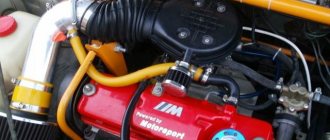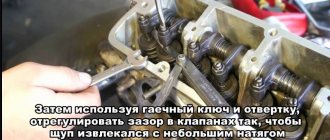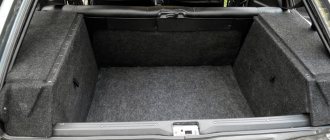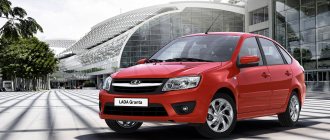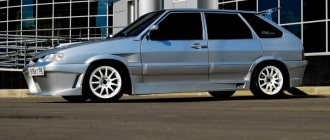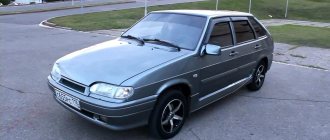VAZ 211440 is an improved version of the VAZ 2114, which, in turn, was released as a restyling of the “nine”. VAZ 211440 features of the model. The car was constantly refined by the manufacturer in order to optimize its technical characteristics and make it more comfortable to use. Two modifications were released, code 211440-24 (2009) and 211440-26 (2010).
VAZ 211440
TECHNICAL CHARACTERISTICS OF THE FOURTEENTH
First, let's look at the main characteristics of the VAZ 2114.
The fourteenth model is a 5-door hatchback, with the following body dimensions (mm): L – 4112, W – 1650, H – 1402. Vehicle weight – 970 kilograms, maximum loading weight – 470 kg.
The wheelbase of the VAZ 2114 is similar to the nine - 2460 mm, the track between the front wheels is 1400 mm, the rear - 1370 mm. In all modifications, the fourteenth has a front drive axle. Ground clearance between the body pan and the road is 170 mm.
The car is equipped with a 5-speed manual transmission with the following gear ratios:
- First speed – 3.636;
- Second – 1.95;
- Third – 1.357;
- Fourth – 0.941;
- Fifth – 0.784;
- Reverse – 3.53.
The fuel tank of the fourteenth holds 43 liters of gasoline. The fuel recommended by the manufacturer is AI95.
The VAZ 2114 has front disc brakes and drum brakes at the rear. The braking distance of a loaded car at a speed of 80 km/h is 38 meters.
The VAZ 2114 was produced with two engine options - 8 and 16 valves. All the differences between them are discussed in detail in the last section of the article.
Cooperation with Super-Auto
Every domestic car enthusiast would like to buy a Russian car with modifications to some of the car’s parts. provided such an opportunity in 2011. The Lada 2114 engine is not just improved or modified, but a new one - from Priora. The car's suspension was also replaced: struts, drums and brakes. The front seats in the cabin have been replaced. Thanks to the “Prior” struts, the car’s ground clearance has increased by 5 mm. At the time of the car's release, the cost was 310,000 rubles.
The acceleration dynamics of a car with a new engine has increased significantly (11 s). On average, fuel consumption was 7.6 l/100 km.
DIFFERENCES between VAZ 2114 and VAZ 2109
Since the fourteenth, in fact, is a modified version of the nine, it is necessary to understand what the main difference between the VAZ 2109 and the VAZ 2114 is.
Let's go through the most significant points.
- Body
In terms of dimensions, the fourteenth differs slightly from the nine - it is 10 centimeters longer and 40 kg heavier. The ground clearance and wheelbase have not undergone any changes.
The differences in the body are quite significant - the presence of a new hood, headlights, radiator, bumpers and moldings create the impression of a completely new car. If we talk about the quality of the metal, then things are much better in the fourteenth model - with proper care, it does not rot even in the most problematic places.
- Engine and suspension
The base model of the VAZ 2114 was equipped with an 8-valve 1500 cm3 engine, similar to the one on the Nine, but in 2007 models with a 1.6-liter engine that complied with the Euro-4 standard with an electronic gas pedal and an electric throttle began to roll off the assembly line.
In 2010, the “Super-Auto” modification went on sale with a 16-valve power unit, which is superior to the Nine engine in all respects.
The chassis of the fourteenth, in comparison with the VAZ 2109, did not undergo any serious design changes.
- Salon
The interior is one of the key advantages of the fourteenth in comparison with the VAZ 2109. The first thing that stands out (thanks to the use of hard plastic), whereas in the nineth, this was one of the main problems.
Specially invited foreign designers worked on creating the interior of the cabin, so it is visually comparable to the interior of middle-class foreign cars of the same year of manufacture.
Unlike the Nine, the interior of the VAZ 2114 is distinguished by softer shapes and the presence of various little things - power windows, new seats, illuminated ashtrays, which significantly improve the comfort of both the driver and front passenger.
The functionality of the interior has also improved significantly - the instrument panel is equipped with an on-board computer, which informs the driver about the status of the main vehicle systems, ambient temperature, current time and has many useful functions.
2114 and 2109
Inside the interior of VAZ 211440
Since the Lada 211440, like its predecessor, is a budget car, the interior decoration is quite modest. Plastic is used for the dashboard. The rear seats of the car fold out, allowing you to increase the rather small luggage compartment. In the “Lux” package, artificial leather and velor are used for interior trim.
Salon of VAZ 2114
Of the positive aspects of the interior decoration of the VAZ 211440, the following are usually noted:
- reduced noise level compared to previous versions of the VAZ;
- possibility of interior lighting, instrument lighting;
- more modern design, predominance of smooth lines, use of practical upholstery materials.
At the same time, there are still some disadvantages, among which are most often mentioned:
- cramped interior - sometimes there is not enough space for rear passengers;
- preserved creaking of the plastic dashboard;
- no power windows for the rear windows;
- lack of airbags and seat belt tensioners.
Salon VAZ 211440
However, these shortcomings, in addition to the interior dimensions, are quite easy to improve. As for the dimensions of the car, its small dimensions provide it with fairly high maneuverability, which cannot be said about large cars.
The main “sores” of the car
The car has a lot of problems, and if you don’t take care of the car right away, it will serve you for very little time. First of all, the car body is the weakest point of the fourteenth family. It begins to rot 3 years after the car leaves the assembly line. Particular attention should be paid to the sills, wheel arches, trunk lids and hood. It is possible to combat this problem. Many owners treat the body with an anti-corrosion coating.
Antifreeze leakage is another car problem. You need to carefully monitor the hose clamps and the lid of the antifreeze tank. It is necessary to tighten all hose connections with clamps in a timely manner. The handbrake can often become loose or not work at all; the problem is solved by replacing the cable.
Headlight bulbs burn out almost every year. Therefore, it would be a good idea to carry spare lamps with you so as not to end up in an unpleasant situation. You need to pay special attention to the condition of the brake pads, especially before preparing for winter. Another characteristic problem of this car is found in the interior - after several years of operation, the ceiling sags. It is necessary to pay attention to the floor of the car, water often accumulates there, which can lead to corrosion.
Conclusion
So, let's summarize. The Lada 2114 car cannot be called a comfortable and luxurious car. The build quality and parts leave much to be desired. But it’s also impossible to call this car completely bad. For its price (250,000 rubles), this is a worthy option for young people, as well as as a car for every day. Availability and low price of spare parts is one of the important advantages. The car does not have air conditioning, cruise or climate control, or leather seats, but this car was created as a budget car.
If desired, this car can become a construction kit for those who like to tinker with the car. Also, the VAZ-2114 is suitable for novice drivers who are looking for an inexpensive car.
Features of the power unit
The first “fourteenth” VAZ models were equipped with injection engines characterized by a displacement of 1499 cm³ and a power of 57.2 kW. Since 2007, under the hood of the Lada 2114 Samara-2 there was a four-stroke gasoline engine with a displacement of 1599 cm³, providing a power of 59.5 kW or 80 hp. With. This engine met the parameters of the Euro 3 eco-standard. The latest modernized model with the index 211440-24 has a sixteen-valve engine with an output of 89 horsepower.
The power supply system using distributive (phased) injection provides high dynamic capabilities, ensuring acceleration to 100 km/h in just 13 seconds. The maximum speed of the VAZ 2114 is 160 km/h. At the same time, the car consumes gasoline economically - only 9 l/100 km in the city.
A special feature of the engine characteristics of this model is the original location of the ceramic catalyst - near the engine itself (unlike its predecessors, which had a catalyst under the bottom). The difference between the cylinder block of the VAZ engine of the “fourteenth” model Lada Samara-2 is its changed volume, achieved by increasing the height of each of the cylinders by 0.23 cm.
Improved aerodynamics
The VAZ 2114 car excels in aerodynamic characteristics thanks to its well-designed body lines, providing excellent streamlining. As a result of the change in appearance, the drag coefficient has decreased.
External aerodynamic improvements of the Lada2114 Samara-2 also affected changes in the position of the air flow separation point. To do this, the designers had to change the angle of inclination of the most aerodynamically active front part of the car - the hood. The front fenders have also undergone changes.
As a result of the redistribution of the air flow, a smaller part of it is directed under the bottom, while the larger part is directed onto the hood and spreads over the body. These characteristics change the amount of total lift force, as a result of which the front and rear axles are unloaded. The even distribution of lift force allows the hatchback to behave in a balanced manner during high-speed driving.
History of creation
The first prototype of the hatchback, which currently bears the name VAZ-2114, was assembled back in 2000. A year later, the Volzhsky Automobile Plant produced the first pilot production batch of 50 VAZ-2114 cars, and in the same 2001 the hatchback was first presented to the public. But AvtoVAZ was in no hurry to put the new model on the assembly line. The reason was that at that moment the predecessor of the VAZ-2109 was still on the assembly line, which, by the way, was in quite high demand.
Serial production of the updated “nine” in the form of the VAZ-2114 began only in 2003, and for a whole year both hatchbacks VAZ-2109 and VAZ-2114 were produced by the car plant in parallel. In 2004, after the “nine” was discontinued from production, the VAZ-2114 fully took its place.
From that moment on, the car was repeatedly modernized and some changes were made to the design, the interior design, the engine and much more were changed. Various modifications of the VAZ-2114 car were produced not only in Russia, but also in Ukraine. At the end of December 2013, 10 years after the start of mass production, the 5-door hatchback VAZ-2114, like the entire family with the unofficial name “Samara 2”, was discontinued.
Lowriders movement
The Low Rider movement originated 60 years ago in the USA. In Russia, it has only now become relevant for car enthusiasts, and is especially popular among young people. “Low Riding” is a lowering of the car’s suspension; the lower the car “lies”, the better.
"Lada 2114" was no exception in this style. After shortening the suspension spring, the car becomes more stable. The appearance of the car is not for everyone; many criticize the style of lowered cars.
Also newfangled was the installation of air suspension on the fourteenth family. The advantage of this suspension is that the ground clearance can be adjusted. The cost of air suspension reaches 100,000 rubles.
As a rule, only original and branded wheels are installed on the car, or even left on standard wheels. Thousands of drivers spend a lot of money on modifying the “fourteenth”. In the photo, the Lada 2114 is presented in a lowered version.
Transmission and chassis
All front-wheel drive cars of the VAZ family have a fundamentally similar chassis design. The front suspension is based on the MacPherson system, the rear suspension is a trailing arm. The steering, typical for all models, is rack and pinion.
Lada 2114 Samara-2 is equipped with a manual gearbox. The car is equipped with a five-speed gearbox (gearbox) with a rocker drive. Fundamentally, its design is similar to all those installed on other vase models. The main pair has a distinctive gear ratio of 3.7.
Street racing on the "fourteenth"
The standard equipment of the VAZ-2114 cannot compete with its more famous competitors, such as BMW, Subaru or Mazda, in terms of acceleration dynamics. But there are still brave souls who challenge such machines. Naturally, this won’t be possible without some modifications to the engine compartment. Speed lovers spend hundreds of thousands of rubles on their cars. Lada 2114 is often seen at Drag Racing events. To add more horsepower to the car, there are two options: install a turbocharger or build a naturally aspirated engine. The second option is the most difficult to implement, but it is more reliable.
An intercooler is added to cool the air pumped by the turbine. But, having installed a powerful engine, it is necessary to modify the gearbox, as well as the brakes. After the work has been completed, the machine’s power reaches 200 hp. With. And thus the inconspicuous “fourteenth” on the road turns into a “beast”. Acceleration to hundreds can be achieved in 7 seconds.



